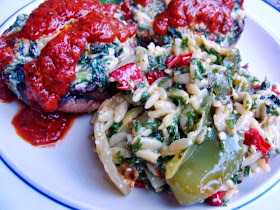When I posted this blog post about a recent picnic, I promised to post the recipe for my multi-grain inari sushi. It took me a few years to get this recipe right-- I had tasted enough bland and either dry or mushy brown rice sushi in my time to make me determined to do better! I wanted a sushi that was nutritious, and delicious enough so that anyone eating it would enjoy it for what it was and not immediately think " health food"!
My rice mixture is made from
short grain brown rice with some millet or quinoa added, and it is nicely seasoned. The grain mixture provides variety and extra nutrients,
but the texture of the rice predominates, which is what I prefer. (I find the millet or quinoa grains too small and separate to use alone in sushi.) This whole grain sushi mix does not taste
heavy or starchy, and I was happy to discover that the seasoned fried tofu pockets or pouches (agé)
are less calorific and fat-laden than I had assumed-- the seasoned ones contain only about 60 calories per pouch. We love it for summer meals.
BTW, inari sushi is great for anyone (like my
husband) who does not like seaweed, and it makes great picnic food. It should not be refrigerated, since this
makes the rice hard, so plan to eat it up in one day (which is not a difficult feat!).
I hope you enjoy this sushi!
Printable Recipe
I hope you enjoy this sushi!
 |
| This was a batch of my multi-grain inari sushi, tops dipped in toasted sesame seeds, that I made for a picnic with friends a few weeks ago. |
BRYANNA'S
MULTI-WHOLE-GRAIN INARI SUSHI (SUSHI GRAINS IN FRIED TOFU POCKETS/AGÉ)
Makes 16 pockets
Makes 16 pockets
16 storebought seasoned inari sushi pouches (You can buy them refrigerated in Asian grocery stores in small packets, or in cans on amazon and from online Asian food venders.)
OR, if you are preparing your own seasoned inari sushi pouches, you will need:
1 package (80 g-- 8 pieces) of abura agé (plain, unseasoned Japanese fried tofu rectangles), cut across in half to make "pouches" (You can buy them refrigerated or frozen in Asian grocery stores and some natural food stores in small packets.)
Flavoring Broth:
1 c. vegetarian broth
2 T. soy sauce or tamari
2 T. unbleached light organic sugar
2 T. dry sherry or mirin (Japanese rice
wine) (or a non-alcoholic sweetish white wine)
FILLING:
(To cook the grains, for each one, bring the water and
grain to a boil in a heavy pot with a tight lid, turn down to low and cook
covered for the time indicated.)
Grain Choice #1:
3/4 c. Japanese short grain brown rice + 1/4 c. toasted millet, cooked together 40-45 minutes in
3/4 c. Japanese short grain brown rice + 1/4 c. toasted millet, cooked together 40-45 minutes in
1 1/2 c. water
(Toast the millet in a dry heavy saute pan or skillet over medium heat, stirring all the while, until light brown and fragrant. If the grains start to pop, reduce the heat.)
OR Grain Choice #2:
1/2 cup Japanese short grain brown rice cooked
in 2/3 cup water for 45 minutes
1/2 cup quinoa cooked separately in 1 cup water for 15 minutes
(Let the quinoa stand, covered, off the heat 10 minutes.)
Seasoning:
2 T. plain rice vinegar
2 T. unbleached light organic sugar
3/8 tsp. salt
Optional but recommended: 1 T. dry sherry or mirin (Japanese rice wine)
Additions: (Traditionally, only seasoned rice is used for filling, but I like to add some color and texture with vegetables.)
1/2 c. frozen baby peas, thawed
1 medium carrot, peeled and finely grated
Optional: toasted sesame seeds
to taste
If you are preparing your own seasoned inari sushi pouches, cut each piece of abura agé tofu across in half. Pour boiling water over them, then drain and
squeeze them carefully to remove the oil.
In a medium pot, bring the flavoring broth
to a boil, add the tofu pockets and reduce the heat. Simmer for 5 minutes, turning now and then. Drain and cool until you can handle
them. Gently squeeze out excess liquid.
Whichever type of seasoned pouches you are using-- store-bought or home-prepared-- carefully separate one “wall” of each pocket from the other to make the pouches.
Whichever type of seasoned pouches you are using-- store-bought or home-prepared-- carefully separate one “wall” of each pocket from the other to make the pouches.
Dump the hot cooked rice (make sure it is
tender) and the millet or quinoa into a large shallow baking dish. Mix the sugar and salt with the vinegar and
wine until it is dissolved. Pour this
over the hot rice. Turn the rice mixture
with a small spatula (wooden, preferably, or a bamboo rice paddle), using an over-and-under-motion, until the
mixture is cool. (Traditionally, you fan
the rice while you mix.)
Add the peas and carrots and a bit of the
optional toasted sesame seeds, if you like. Stuff the pockets carefully
and evenly (there should be just enough filling for 16 pockets). Traditionally the pouches are not stuffed full and the pouch is pinched closed at the top, but, as you can see in the pictures, I usually fill them full full and leave them open at the top.
If you like, you can dip the tops in toasted sesame seeds. Serve at room temperature. Rice gets hard when refrigerated, which spoils the texture of the dish, so the sushi pouches should be eaten the same day they are made.
Enjoy!
If you like, you can dip the tops in toasted sesame seeds. Serve at room temperature. Rice gets hard when refrigerated, which spoils the texture of the dish, so the sushi pouches should be eaten the same day they are made.
Enjoy!






















